
- Homepage
- Blade Edge
- Blade Material
- 1095 Carbon Steel (7)
- 20cv (6)
- Bohler M390 (5)
- Carbon Steel (731)
- Cpm-20cv (11)
- Cpm-s30v (5)
- Cpm-s35vn (9)
- D2 Steel (6)
- Damascus (17)
- Damascus Steel (190)
- Elmax (9)
- Elmax Steel (5)
- Folded Carbon Steel (6)
- Folded Steel (34)
- High Carbon Steel (14)
- M390 (26)
- S35vn (19)
- S90v (7)
- Stainless Steel (462)
- Steel (8)
- Other (789)
- Blade Range
- Blade Type
- 0452cf (4)
- Cleaver (5)
- Clip Point (237)
- Dagger (7)
- Drop Point (334)
- Drop Point, Tanto (4)
- Harpoon (7)
- Hawkbill (17)
- Karambit (20)
- Leaf (13)
- Pen (6)
- Reverse Tanto (6)
- Sheepsfoot (29)
- Spear Point (78)
- Straight Back (8)
- Tanto (66)
- Trailing Point (10)
- Upswept (7)
- Upswept Skinner (3)
- Wharncliffe (74)
- Other (1431)
- Brand
- Artisan (17)
- Benchmade (51)
- Bestech Knives (57)
- Boker (37)
- Boker Plus (19)
- Case (28)
- Case Xx (55)
- Damascus (39)
- Fox (35)
- Kansept Knives (65)
- Kizer (25)
- Lionsteel (22)
- Qsp Knife (18)
- Sj Shi Jian (134)
- Sog (25)
- Spyderco (149)
- Swords' World (41)
- Viper (29)
- We Knife Co Ltd (19)
- Zero Tolerance (55)
- Other (1446)
- Dexterity
Elegant Blue Sharp Japanese samurai sword katana Folded steel clay tempered
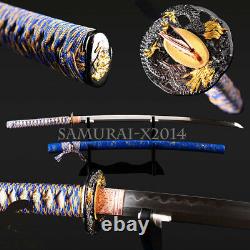
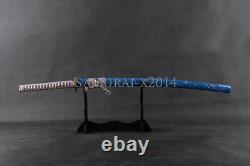
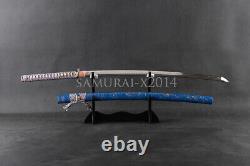
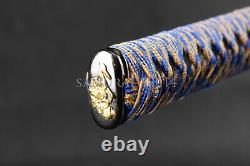
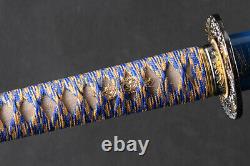
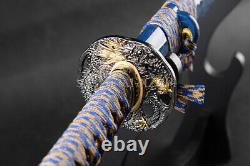
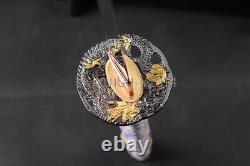

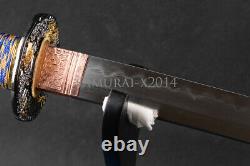
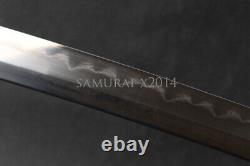
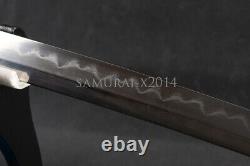
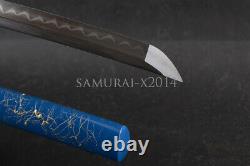
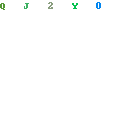

Elegant Blue Sharp Japanese samurai sword katana Folded steel clay tempered. Craft: Folded steel, Clay tempered.
Overall Length: 40.6 inch /103 cm Tsuba: Alloy Blade Length: 27.5 inch / 70 cm Menuki: Alloy Handle Length: 10.24 inch / 26cm Habaki: Brass Blade Width: 1.26 inch / 3.2cm Seppa: Top grade brass Blade Thickness: 0.28inch / 0.7cm Rayskin: White imitative rayskin Blade material: 1095 carbon steel Ito & Sageo: Synthetic silk sageo Saya :Gold lines shinny blue wooden saya Tang: Full tang. FULL TANG: it is common to find swords which have a rat tail tang (two pieces welded together), a thin tang or even no tang at all, all of our Japanese swords have a thick tang running from the blade to the full length of the handle.
Commercial "folded" steel swords are made by layering multiple sheets, usually of two different steels, and then welding them by hot-rolling the entire stack. The completed stack is then rolled thinner and cut to blanks the size needed for each blade. These blanks may then be drop-forged or water-jet cut to shape them. The blanks are then ground down to form the edges, exposing the folds.Due to the comparative ease of manufacturing and greater efficiency (in the sense that less of the sheet tends to be lost during the stamping process), this method is most commonly seen in the manufacture of straight "damascus steel" swords such as sword canes and what are often called "double-edged samurai swords" but which are really just Chinese-style ken swords with Japanese-style fittings. After the blade has been shaped, the sword would be quenched.
Today we quench our swords in either water or oil. Quenching a sword in water is more difficult to control, but yields better results.
The defect rate is about five times higher than oil quenching, which is much more stable and easier to control. Blades quenched in oil are still considerably hardened and do have superior flexibility compared to a water quenched blade. The more rapidly a blade cools down, the harder it becomes.
Thus, when a hot blade enters the water, the water also gains heat and the blade will cool more gradually. Therefore, the first part of the blade that enters the water will be the hardest.
Aond the technique of quenching was also very important. Katana swords would simply enter the water edge and tip first, leaving the spine or back and lower section of the blade softer. This was also done for practical reasons, as the'softer' sections were better for absorbing shock and impact and employed for defensive measures.
The culture of Japanese sword. The sword/nihonto in Japan was called Katana. But according to the sword shape and size, there are Tachi swords, Katana, Wakizashi and short(Tanto) swords. The famous swords exsist with graceful outlooking as a weapon and some are also as arts and collections. Each Samurai warrior kept two swords on his person - a long sword/Katana, and a short sword/Wakizashi.These swords were his principal weapons gut they also were an expression of his class and personality. The Katana is more suitable for the Long distance, and the Wakizashi usually used in the short distance. Because of the length difference, the Wakizashi will take less time when you take the blade out of the saya. There are two kinds of martial arts which trained the use of the swords: Ken-do and Iai-do. Ken-do trains how to fight and the person being trained wears a protector and fights with a sword made of bamboo.
The cross sectional shape of the grip of his bamboo sword is round. Iai-do teaches the skill of drawing a sword and striking with it.
The cross sectional shape of the sword grip is oval. Iai-do teaches several techniques of how to respond in many different situations of combat.
"Hagakure" (literally it is "the shadow of the leaves") is a text of the Bushi, a class of the Samurais, which says, The way to be a Bushi is finding how to die. Loyalty and faith are most important. The Ken, or sword, is the spirit of the Bushi. To die for one's lord and for Ken is for their honor. To be killed by the Ken is an honorable way to die. We sometimes got the question of people ask can the sword cut iron/wire? " or "can the sword cut bone? It is not wise if you bought a Japanese sword which is sharpened to cut iron/wire, no matter how much your sword is, carbon steel or folded steel, clay tempered or not, that will make the edge of the sword turned or break down the blade. After that you will waste a lot of time to do the maintainence if that is still useful. What you see in the movie or video show that the sword can cut the hair with one breath;cut the iron/wire just like cut the mud, those are one-sided and exaggerated. They make the sword mythical. That is not impossible that there is no hurt or damage with the blade at all after Tameshigiri, just do the maintenance well. In the real life if that is in a fighting, the right way to stop the opponent is with the back of the blade but the cut edge, if you want to do a cutting test, you can cut the bamboo trees(fresh), tatami or slice paper to instead of cuttint the wire.We have the Chinese sword which can cut wire, if you are interested in, you can go and check in our store. The blade of that swords are usually very thick and heavy and sharpness is not so good as the Japanese swords.
If you don't like the original mountings, you can choose the favorite ones from the options. Handle wrapping cord and saya cord should be the same color. If you only want to change one of them to another color, please inform of it specially. We can engrave English words, Chinese Characters on the blade for free. We can add or remove the machine-made wavy hamon for free. Usually thought be used for bloodletting only. It is also used to lighten the weight of the sword. We can add or remove Bo-hi for free. Most of our blades are sharp. We can also make the blade unsharpened for free if you require. The price varies from different swords. International Buyers - Please Note. Please contact with us before you leave feedback. We will try our best to solve the problem for you, thank you. Sometimes, you may not get our reply immediately due to the time difference among each country.However, please be assured that we'll strive to reply you as soon as possible once we got your messages. This item is in the category "Collectibles\Knives, Swords & Blades\Swords & Sabers\Asian\Japanese". The seller is "swords001" and is located in this country: CN. This item can be shipped worldwide.
- Type: katana
- Tang: Full
- Handle Material: Wood
- Blade Material: Carbon Steel
- Theme: Samurai
- Dexterity: Right-Handed
- Edge: Single, Curved
- Handedness: Double-Handed
- Brand: SJ SHI JIAN
- Color: Blue
- Country/Region of Manufacture: China
- Original/Reproduction: Original
- Style: Japanese

